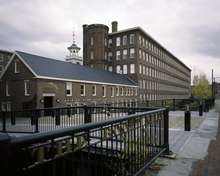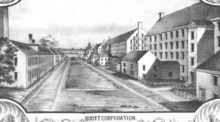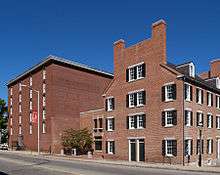Boott Mills
The Boott Mills in Lowell, Massachusetts were a part of an extensive group of cotton mills, built in 1835 alongside a power canal system in this important cotton town. Their founder was Kirk Boott, one of the early mill owners in Lowell.[1] Today, the Boott Mills complex is the most intact in Lowell and is part of Lowell National Historical Park. It houses the Boott Cotton Mills Museum.

Location
Lowell is 40 kilometres (25 mi) north-west of Boston on the Merrimack River. Lowell was blessed with a river system that provided a 9 metres (30 ft) drop over a distance of 2 kilometres (1.2 mi), suitable to provide 7,460 kilowatts (10,000 hp). Water had been diverted through canals and locks to enable navigation, and by a simple diversion the overflow could be used to power waterwheels.
History
Kirk Boott worked for the company responsible for the Merrimack Canal the first power canal in Lowell, which was already driving other mills, and built his mills in 1835- staffing them using the Waltham-Lowell system. Running off of hydropower, the original operation consisted of four gable-roofed brick mill buildings. Eventually, floors were added, giving them flat roofs, the buildings were connected by stair towers and clock towers, and other buildings were added to the complex as well. Steam power and electric power were eventually introduced.
Decline
The New England textile industry was in decline by World War I and collapsed after World War II; the Boott Mills ceased operations in 1958. In the late 1970s, they became a key component of the Lowell National Historical Park, largely because the complex stood virtually whole, unlike other complexes which had suffered fires, or selective or wholesale demolition, like the older Merrimack Manufacturing Company. Additionally, the Boott Mill still contains buildings dating from the 1830s, as well as containing new structures, dating closer to 1900. As such, it is a catalog of industrial development over that time period.
Boott Cotton Mills Museum
The Boott Mills are now an example of adaptive re-use; they contain the National Park weave room exhibit, condos, apartments, and offices.[2] Renovations of certain buildings still continues. A single row of Mill girl housing, built for the early operatives under the Lowell System, still stands after an extensive renovation, and features exhibits as well.
See also
References
External links
| Wikimedia Commons has media related to Boott Mills. |
- Boott Cotton Mills Museum - Lowell National Historical Park
- Historic American Engineering Record (HAER) No. MA-16, "Boott Cotton Mills, John Street at Merrimack River, Lowell, Middlesex County, MA", 62 photos, 5 color transparencies, 100 measured drawings, 101 data pages, 5 photo caption pages
- The Boott Cotton Mills of Lowell, Massachusetts
Images
 Boott Corp, 1850
Boott Corp, 1850- Boott Mills Power Loom in operation, 2015
 Boardinghouse and storehouse, 2005
Boardinghouse and storehouse, 2005 Inner courtyard, 2005
Inner courtyard, 2005 Boott Mills east courtyard, 2014
Boott Mills east courtyard, 2014- The exhibit, 2014